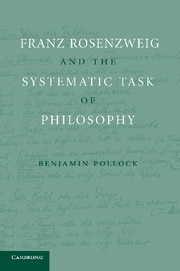Book contents
- Frontmatter
- Contents
- Acknowledgments
- Introduction: The Star of Redemption as “System of Philosophy”
- 1 System as Task of Philosophy: “The Oldest System-Program of German Idealism”
- 2 “A Twofold Relation to the Absolute”: The Genesis of Rosenzweig's Concept of System
- 3 Alls or Nothings: The Starting-Point of Rosenzweig's System
- 4 “The Genuine Notion of Revelation”: Relations, Reversals, and the Human Being in the Middle of the System
- 5 Seeing Stars: The Vision of the All and the Completion of the System
- Conclusion: The All and the Everyday
- Bibliography
- Index
5 - Seeing Stars: The Vision of the All and the Completion of the System
Published online by Cambridge University Press: 28 July 2009
- Frontmatter
- Contents
- Acknowledgments
- Introduction: The Star of Redemption as “System of Philosophy”
- 1 System as Task of Philosophy: “The Oldest System-Program of German Idealism”
- 2 “A Twofold Relation to the Absolute”: The Genesis of Rosenzweig's Concept of System
- 3 Alls or Nothings: The Starting-Point of Rosenzweig's System
- 4 “The Genuine Notion of Revelation”: Relations, Reversals, and the Human Being in the Middle of the System
- 5 Seeing Stars: The Vision of the All and the Completion of the System
- Conclusion: The All and the Everyday
- Bibliography
- Index
Summary
On october 4, 1918, six weeks into the composition ofThe Star of Redemption, Rosenzweig writes a letter to Margrit Rosenstock recounting a striking vision he beheld the previous night. The details of this vision, and Rosenzweig's own interpretation of it, shed surprising light on the systematic articulation of the One and All Rosenzweig undertakes in the Star and upon the shape in which the One and All becomes manifest in the book. Rosenzweig's letter at once presents the context within which, I will claim, the third and final part of the Star should be understood. An interpretation of this letter will thus serve to introduce those questions that will guide us in this final chapter of our study of the Star as a system of philosophy.
As he explains in the letter, Rosenzweig had worked late into the previous night finishing the “Transition” section that ends the first part of the Star and had begun writing the introduction to the book's second part that very morning. According to Rosenzweig, the position of limbo he found himself in during the middle of the previous night, between the first and second parts of the book, suddenly permitted him to see the “Star of Redemption” – quite literally – in its entirety:
I was still fi nishing the Transition chapter last night; it became quite crazy, and all the spirits were so let-loose that I couldn't sleep anymore aft er midnight. … Th ese are the moments in which one sees double [Doppelgänger] … because one is no longer glued right fi rmly in one's body. […]
- Type
- Chapter
- Information
- Franz Rosenzweig and the Systematic Task of Philosophy , pp. 258 - 311Publisher: Cambridge University PressPrint publication year: 2009

